
发布时间:2022-03-10
瑞士生活|3月1日纳沙泰尔州州庆节
引言
纳沙泰尔州州庆节是瑞士的一个地区性公众假日,在每年的3月1日这一天,只有纳沙泰尔州会举办节日庆典。这一节日是为了纪念纳沙泰尔州在1848年3月1日加入瑞士联邦,不再受普鲁士管辖(普鲁士为16世纪至20世纪初的德意志帝国)。自1848年起,纳沙泰尔州每年都会庆祝该州的这一独立日。
瑞士的历史
在介绍纳沙泰尔的历史之前,让我们先来上一节简单的瑞士历史课吧。瑞士,或称赫尔维蒂联邦(Helvetic Confederation,瑞士的缩写CH就源于此),是由反对哈布斯堡王朝(今天的奥地利)的各州于1291年组成的,但直到1848年新宪法通过后,现在的国家才形成。当时,乌里(Uri)、施维茨(Schwyz)和下瓦尔登(Unterwalden)这三个位于山谷的共同体结成联盟,以更好地保护自己免受外国势力的攻击。在14和15世纪间,旧瑞士邦联发展成为一个由农村和城市公社组成的松散联盟网络。随后联邦以各种方式不断扩大,直到1815年,纳沙泰尔也成为了联邦的一部分。
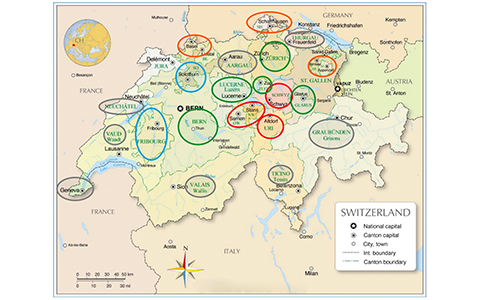
赫尔维蒂联邦的发展历程如下 :
1291年:乌里(Uri)、施维茨(Schwyz)和下瓦尔登(Unterwalden)是第一批结成联盟的州。
1332年至1353年:苏黎世(Zurich)、伯尔尼(Bern)、卢塞恩(Luzern)、格拉鲁斯(Glarus)、楚格(Zug)加入联盟,形成了旧邦联。
1481年:弗里堡(Fribourg)和索洛图恩(Solothurn)加入了旧邦联。
1513年:巴塞尔(Basel)、沙夫豪森(Schaffhausen)和阿彭策尔(Appenzell)加入。
1648年,瑞士正式脱离神圣罗马帝国的统治。
1803年至1815年间:圣加仑(St Gallen)、格劳宾登(Graubünden)、阿尔高(Aargau)、图尔高(Thurgau)、提契诺(Ticino)、沃州(Vaud)、瓦莱(Valais)、纳沙泰尔(Neuchâtel)和日内瓦(Geneva)这九个地区成为了瑞士的一部分。
1815年,欧洲列强在战胜拿破仑后,希望重新建立革命前的形态。于是,瑞士在1815年的《联邦条约》中,赋予了各州几乎全部的自治权。
同年,纳沙泰尔州奉行联邦条约,并加入了赫尔维蒂联邦。然而,1814-1815年欧洲各国之间举行的维也纳会议,将普鲁士国王认定为纳沙泰尔亲王,并将纳沙泰尔认定为瑞士的一个州,这种一州两属的情况头一次出现在了瑞士。这意味着纳沙泰尔并不完全独立,仍然处于普鲁士人的统治之下。
直到1848年,革命者在当地军队士兵弗里茨·库瓦西埃(Fritz Courvoisier)的领导下,从纳沙泰尔山区的一个小城市力洛克(Le Locle)出发,前往纳沙泰尔市,才最终赶走了普鲁士人。纳沙泰尔至此终于成为了一个完全独立的州,可以自由民主地选择其当局了。
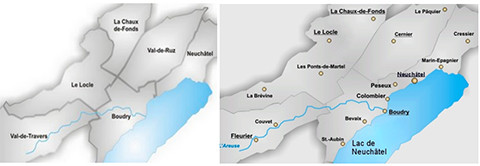
纳沙泰尔州地图
因此,1848年3月1日作为历史上的 “纳沙泰尔独立日”被人们铭记,每年的3月1日,纳沙泰尔州都会举州欢庆这一传统节日。
从山区到纳沙泰尔
1848年2月,纳沙泰尔人民的精神觉醒了。1848年2月28日至29日的夜间,共和党人顶着严寒,在力洛克展示了瑞士的联邦旗帜。
当天晚上,纳沙泰尔山区的所有村庄都加入了这场变革运动。革命领袖弗里茨·库瓦西埃任军事指挥,在拉绍德封(La Chaux-de-Fonds,如今是纳沙泰尔州的第二大城市)集结武装了近三百名革命者。
1848年3月1日早上7点,共和党人开始在库瓦西埃的带领下向城堡行进。当时乡间的雪深达一米,行进很困难,库瓦西埃只能骑在马背上带领大家前进。在朝着纳沙泰尔南下的过程中,又有100人加入了他们。队伍在到达纳沙泰尔以北几公里处的瓦朗金(Valangin)时,夺取了两门大炮。没有什么能够阻挡他们。在1848年,这30公里的行军是非常艰难的,更别说是在雪天里顶着严寒穿越各种山路。
部分革命者在晚上7点左右占领了城堡。新政府于晚上9点到达,仅用24小时就建立了纳沙泰尔共和政体。3月2日,联邦委员承认了新政府,至此,纳沙泰尔完全成为了瑞士联邦的一部分。
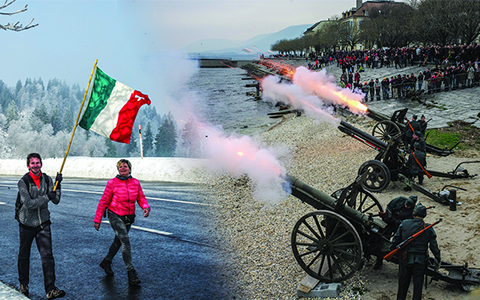
为保留悠久的传统而行进
顾名思义,纳沙泰尔革命纪念游行是在每年的3月1日举行的。在这个只有纳沙泰尔州才有的节日里,当地居民会一大早就在力洛克村聚集,然后一起前往拉绍德封,接下来去阿尔卑斯之景山顶驿站(Relais de la Vue-des-Alpes),再到达瓦朗金,最后前往纳沙泰尔城堡(Château de Neuchâtel)。这条30公里的路线,与1848年打倒普鲁士人的革命军当年采用的路线是一模一样的。
在3月1日这一天,这场纪念纳沙泰尔革命的游行让来自各行各业的人们齐聚一堂。一路沿途会不断有人加入游行队伍,其中大部分是“纳沙泰尔人”("Neuchâtelois"),即生活在纳沙泰尔州的人,无论他们是否是本地人。人们参加这一游行的主要原因是,州庆节是该州独有的节日。不过,来自邻州的人甚至法国人也会时常参加这场节日的庆典。多年来,每一届的游行参与者数量都在增长。在1998年纳沙泰尔共和政体成立150周年庆典期间,游行者甚至超过了6000人。
游行活动流程
游行从力洛克开始。在活动正式开始之前的一个小时左右,第一批参与者就会到达力洛克的钟表博物馆前,接着人们会陆续到来,游行队伍逐渐形成。几乎所有的人都会穿得很暖和,因为在每年的这个时节,气温还很低,还有可能下雪。现场会提供一些茶点,每个人都可以喝一杯茶,品尝一片泰洛勒辫子面包(taillaule)——一种著名的纳沙泰尔黄油甜面包。还会有专门为此次活动设立的委员会的主席发表讲话。
接下来,为此次活动盛装打扮的 “13号炮组”的炮手们,会以一种非常特别的方式为一年一度的游行拉开帷幕。炮手们复现了1853年至1874年间官方炮手的传统,身着那个时代的炮手制服。他们会高声报出开炮之前的各阶段号令。接着,三响炮会燃起,其中的最后一响由委员会主席点燃。
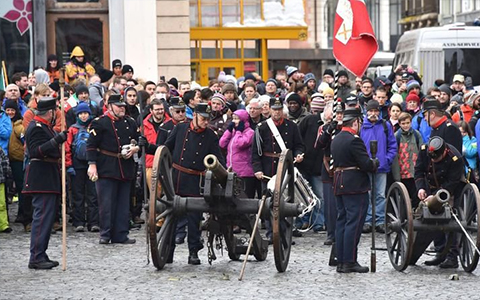
三声炮响后,在9点整,游行就可以开始了。游行者们一边行进,一边交谈,他们时而谈起历年的游行活动,时而停下来拍照,或拿起事先准备好的水瓶喝水...... 路线沿着森林、田野和主干道展开,第一阶段的终点是拉绍德封的市政厅广场。
在拉绍德封的市政厅广场,来自拉绍德封市周边地区的200至300名游行者会加入力洛克的游行者队伍。队伍的组成变得更加多样化,有更多的儿童以及行动不便的人也会加入进来。广场上有移动卫生间、热茶摊位,还有为活动设立的传统 “泰洛勒辫子面包”小铺。委员会主席会在此处欢迎新加入的游行者,并宣布下一个茶点站的位置。主席会指出,有一辆大巴车可供疲惫者和晚到的人乘坐,在纳沙泰尔城堡的集合时间定在下午4点30分。
接着,参与者们会等待炮声信号,然后再次出发。这段路程是上坡方向,有几公里。行走一个多小时之后,就到达了第三程的起点,即阿尔卑斯之景山顶驿站(Relais de la Vue-des-Alpes)。正如驿站的名称所示,这里能看到瑞士中部伯尔尼阿尔卑斯山的迷人全景。茶点同样是提供咖啡和茶,有时还有汤。
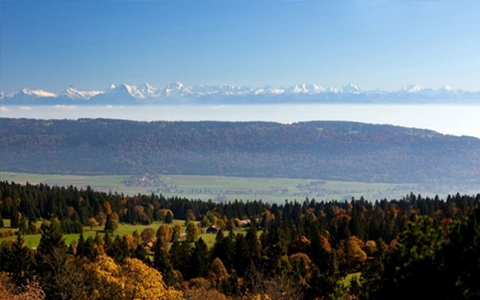
阿尔卑斯之景(Vue-des-Alpes)山顶驿站的景色
此后就全部是下坡路了,直到下一站马尔维利耶(Malvilliers),游行者可以在那里享受热饮,然后南下进入纳沙泰尔市。
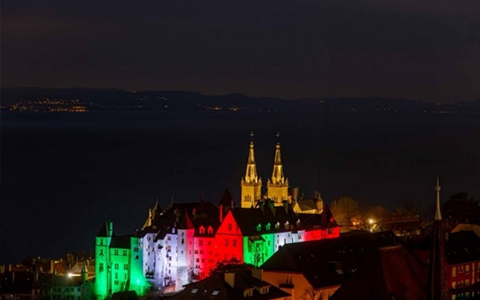
3月1日当天的纳沙泰尔城堡
路线的终点设在纳沙泰尔城堡的庭院里。随着游行者的涌入,庭院也逐渐拥挤起来。车载着 “13号炮组 ”到达旅程终点,炮声再次响起。最后,每个人都会喝上一杯荣誉酒,在一片觥筹交错中,州庆节的庆典活动圆满结束。
The Independence Day of Canton Neuchâtel
Introduction
Neuchâtel’s Republic Day is a Swiss regional public holiday celebrated on March 1st each year in this canton only. This holiday marks the date when, in 1848, Neuchâtel became a republic within the Swiss Confederation. Prior to this, the canton of Neuchâtel was under Prussian rule, a prominent German state from the 16th century to the beginning of the 20th century. This independence day has been celebrated every year since 1848.
The History of Switzerland
Before introducing the history of Neuchâtel, here is a short history class of the country. Switzerland – or Helvetic Confederation, from which the abbreviation CH for Switzerland derives – was formed in 1291 by an alliance of cantons against the Habsburg dynasty, (today’s Austria) though only in 1848, when a new constitution was adopted, was the present nation formed. At that time, the three valley communities of Uri, Schwyz and Unterwalden formed an alliance to better defend themselves against any attacks by foreign powers. In the 14th and 15th centuries, the Old Swiss Confederacy developed as a loose network of alliances of rural and urban communes. The Confederacy's process of expansion unfolded in various ways until 1815 when Neuchâtel itself became part of the confederation.
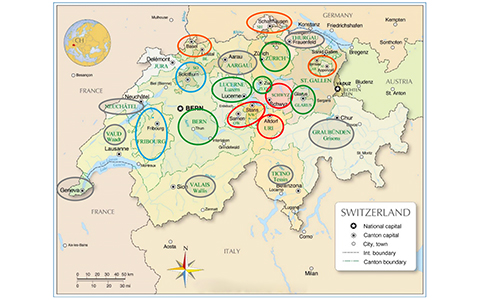
In 1291: Uri, Schwyz, and Unterwalden were the first original cantons to form an alliance.
From 1332 to 1353: Zurich, Bern, Luzern, Glarus, Zug joined the alliance and formed the Old Confederacy.
In 1481: Fribourg and Solothurn joined the Old Confederacy
By 1513: Basel, Schaffhausen and Appenzell had signed on.
In 1648 Switzerland was formally released from the Holy Roman Empire.
Between 1803 and 1815: St Gallen, Graubünden, Aargau, Thurgau, Ticino, Vaud, Valais, Neuchâtel and Geneva, nine more territories became part of Switzerland
In 1815 after their victory over Napoleon, the European powers wanted to re-establish pre-revolutionary conditions. This occurred in Switzerland with the Federal Treaty of 1815, which granted the cantons almost full powers to govern themselves.
That same year, the canton of Neuchâtel adhered the federal pact, and joined the Helvetic Confederation. However, the Congress of Vienna confirmed the King of Prussia as Prince of Neuchâtel and Neuchâtel as a Swiss canton, a hybrid situation that was unique in Switzerland. This meant that Neuchâtel was not fully independent and still under the ruling of the Prussians. It was not until 1848 that the revolutionaries, led by Fritz Courvoisier who was a local soldier in the army, set out from Le Locle, a small city in the Neuchâtel mountains, and descended towards the city of Neuchâtel to definitively drive out the Prussians. Neuchâtel finally became a fully independent canton, free to choose its authorities democratically.
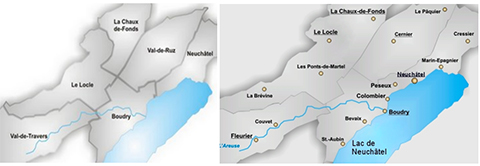
1 Map of Canton of Neuchâtel
Thus, March 1, 1848 remains the date that history will remember as the "Neuchâtel Independence Day", a traditional holiday celebrated throughout the canton of Neuchâtel.
From the Mountains to Neuchâtel
In February 1848, the spirits of the people of Neuchâtel awoke. In spite of the cold, the republicans displayed the federal flag of Switzerland in Le Locle during the night of February 28-29, 1848.
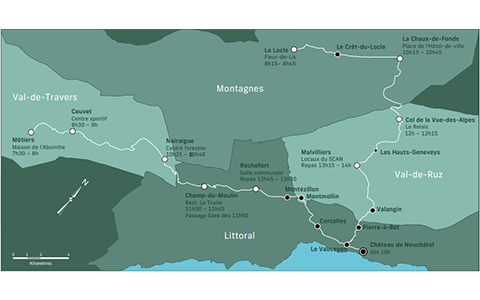
Map of the marches to Neuchâtel
That evening, all the villages in the mountains of Neuchâtel joined the movement. Fritz Courvoisier, the leader of the revolution, took military command and the men gathered in arms in La Chaux-de-Fonds. That night, 200 to 300 revolutionaries in La Chaux-de-Fonds accompanied them.
At 7 am on March 1, 1848, the republicans began marching toward the castle, accompanied by Courvoisier. Because of the snow, up to one meter in the countryside, the progression was difficult. He led the march on horseback. As they started the descent towards the Neuchâtel, additional 100 men joined them. When they arrived in Valangin, a few kilometer before Neuchâtel, the procession took possession of two cannons. Nothing could stop them. In 1848, this 30 kms walk was very demanding, especially to cross the different mountain path in the cold and snowy month.
Part of the revolutionaries took possession of the castle at around 7 pm. The new government arrived at 9pm and established the Neuchâtel Republic in only 24 hours. On March 2, the federal commissioners, called by the former regime, recognizing the new government and thus Neuchâtel became fully part of the Swiss confederation.
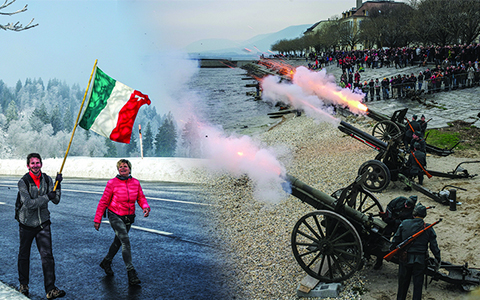
Walking to preserve a long tradition
As its name suggests, the Commemorative March of the Neuchâtel Revolution takes place on March 1st of each year. On the occasion of this holiday, of which Neuchâtel alone has the privilege, the inhabitants of the canton of Neuchâtel gather in the early morning in the village of Le Locle. Together, they will then go to La Chaux-de-Fonds and then to the Vue-des-Alpes relay, and Valangin, and finally head for the Château de Neuchâtel. This thirty-kilometre route follows the one the revolutionaries took, who, in 1848, brought down the Prussians.
The march commemorating the Neuchâtel Revolution on March 1st brings together people from all walks of life. It is carried by all the participants who join the route, most of them being "Neuchâtelois", i.e. living in the canton of Neuchâtel whether they are natives or not. The main reason for this attendance is that March 1st is a holiday only in this canton. However, it happens that people from neighbouring cantons or even French people join the festivities. Over the years, the number of participants increased with each edition, until it reached about 800 people in 2011. It is worth noting that in 1998, during the 150th anniversary of the Neuchâtel Republic, more than 6'000 marchers were present.
Program
At the start of the walk, located in Le Locle, the first walkers arrive nearly an hour before the official start, a troop forming itself little by little in front of the Watchmaking Museum in Le Locle. Almost all of them are warmly dressed, since at this time of the year the temperatures can be very low and the weather can turn to snow. The refreshments start on the spot: everyone can drink a cup of tea and taste a slice of taillaule - a famous Neuchâtel brioche. A speech is also given by the president of the committee which has been specially created for this event.
The departure is then given in a very particular way, renewed each year, by the gunners of the "Batterie 13" who have dressed up for the event. They are official gunners from 1853 to 1874. On this occasion, they prepare the cannon by naming the different stages of the setting up. Then, three shots are fired, the last one being lit by the president of the committee.
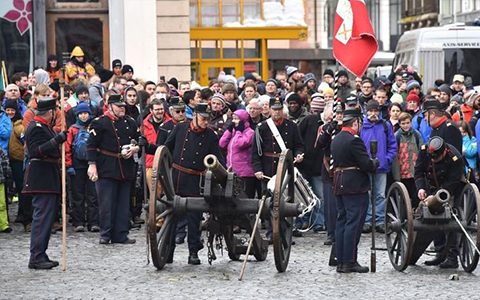
Thus, at 9 o'clock sharp, the march can begin. Discussions are going well and the participants willingly reminisce about past walks, stop to take a picture or drink from their pre-prepared water bottle... The route goes along the forest, the fields and the main road before the first stage ends at the town hall square of La Chaux-de-Fonds, the second biggest city in the Canton.
It is at this point that the walkers from Le Locle are joined by some 200 to 300 other regular walkers from the surroundings of the city of La Chaux-de-Fonds. This crowd is more diverse, with more young children or people with reduced mobility. On the square there are portable bathrooms, hot tea stands and, once again, the traditional "taillaule" set up for the occasion. The president of the committee welcomes the new walkers and announces the next refreshment stops. He or she points out that a bus is available for the most tired and latecomers, the meeting point at the Castle of Neuchâtel being fixed at 4:30 pm.
Once again, the participants wait for the signal given by the cannon shots before setting off again. Then, after several kilometers and more than an hour of climbing, the walkers finally reach the third stage, the Vue-des-Alpes relay. As indicated in the name of the relay, it exhibits a stunning panorama over the Bern Alps in central Switzerland. There, the refreshments are again coffee, tea and sometimes soup.
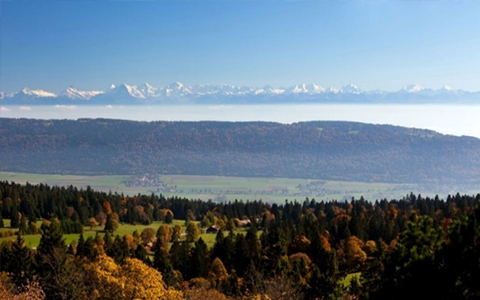
View from Vue-des-Alpes - 3rd Relay
After this, it is all downhill until the next stop Malvilliers where the walkers can enjoy hot beverages before descending into Neuchâtel.
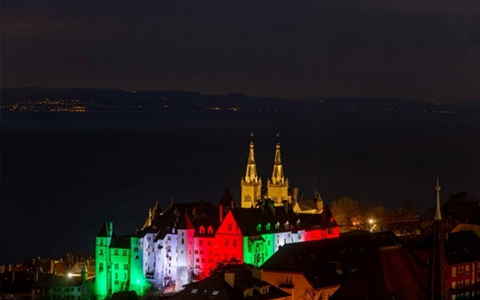
Neuchâtel's Castle - 1st of March
The route then ends in the courtyard of the Château de Neuchâtel, which fills itself up as the marchers pour in. Cannon shots are heard again as the "Batterie 13" finishes the journey by car. The festivities end with a wine of honor offered to everyone.
本文转载自雷梭勒家族办公室,如有侵权,敬请告知删除。
Sooswiss为您提供
瑞士方向私人管家式的定制服务:
1)家族传承 2)财富管理 3)瑞士投资
4)居留计划 5)税务优化 6)家族治理
更多资讯请登录网站 www.sooswiss.com
